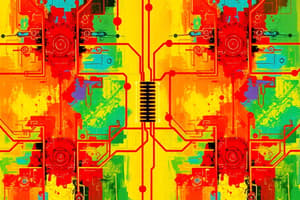Podcast
Questions and Answers
What is the forward voltage drop for a silicon diode in this practical model?
What is the forward voltage drop for a silicon diode in this practical model?
- 0.7 V (correct)
- 0.3 V
- 1.5 V
- 1.0 V
In a practical model, if the input voltage is $1.0 ext{V}$, what is the output voltage assuming the diode is forward biased?
In a practical model, if the input voltage is $1.0 ext{V}$, what is the output voltage assuming the diode is forward biased?
- 1.5 V
- 1.0 V
- 0.7 V (correct)
- 0.3 V
What is the output voltage for a half-wave rectifier during the negative half cycle?
What is the output voltage for a half-wave rectifier during the negative half cycle?
- -Vin
- 0 (correct)
- Vin
- Vin / 2
Which type of diode is specifically designed to provide voltage regulation?
Which type of diode is specifically designed to provide voltage regulation?
For a full-wave rectifier using a center-tapped transformer, what happens to D1 during the positive half cycle?
For a full-wave rectifier using a center-tapped transformer, what happens to D1 during the positive half cycle?
What characterizes the majority carriers in a P-type semiconductor?
What characterizes the majority carriers in a P-type semiconductor?
In a half-wave rectifier with a practical diode, what would be the relationship between Vo max and Vin max?
In a half-wave rectifier with a practical diode, what would be the relationship between Vo max and Vin max?
How is the average output voltage (Vo avg) calculated for a half-wave rectifier?
How is the average output voltage (Vo avg) calculated for a half-wave rectifier?
Which element is typically used for doping silicon to create N-type material?
Which element is typically used for doping silicon to create N-type material?
What is the significance of smoothing by a capacitor in a rectifier circuit?
What is the significance of smoothing by a capacitor in a rectifier circuit?
Which statement is true regarding reverse bias in a diode?
Which statement is true regarding reverse bias in a diode?
Which equation properly represents output voltage for a practical half-wave rectifier during the positive half cycle?
Which equation properly represents output voltage for a practical half-wave rectifier during the positive half cycle?
In a forward biased diode, what happens to the flow of holes and electrons?
In a forward biased diode, what happens to the flow of holes and electrons?
What defines the resistivity change in a semiconductor as a result of doping?
What defines the resistivity change in a semiconductor as a result of doping?
For Silicon, what is the typical forward voltage required for conduction?
For Silicon, what is the typical forward voltage required for conduction?
How does the presence of an acceptor affect the electronic structure of P-type silicon?
How does the presence of an acceptor affect the electronic structure of P-type silicon?
What is the primary function of the resistor in a forward biased diode circuit?
What is the primary function of the resistor in a forward biased diode circuit?
In an N-type semiconductor, which current carriers are in the minority?
In an N-type semiconductor, which current carriers are in the minority?
What is the role of donors in N-type silicon?
What is the role of donors in N-type silicon?
What is the output voltage condition during the negative half cycle of a full-wave bridge rectifier?
What is the output voltage condition during the negative half cycle of a full-wave bridge rectifier?
What is the formula for calculating the peak inverse voltage (PIV) for a bridge rectifier with a practical diode?
What is the formula for calculating the peak inverse voltage (PIV) for a bridge rectifier with a practical diode?
In a full-wave rectifier, what happens to the output frequency compared to the input frequency?
In a full-wave rectifier, what happens to the output frequency compared to the input frequency?
What is Vo rms for a full-wave rectifier circuit calculated as?
What is Vo rms for a full-wave rectifier circuit calculated as?
For a full-wave rectifier using a center-tapped transformer, how is the practical PIV defined?
For a full-wave rectifier using a center-tapped transformer, how is the practical PIV defined?
What is the effect of increased load current (Ip) on the ripple voltage (Vripple) in a full-wave rectifier?
What is the effect of increased load current (Ip) on the ripple voltage (Vripple) in a full-wave rectifier?
During which condition is diode D2 in a full-wave bridge rectifier reverse biased?
During which condition is diode D2 in a full-wave bridge rectifier reverse biased?
When working with ideal diodes in a center-tapped transformer configuration, how is the PIV expressed?
When working with ideal diodes in a center-tapped transformer configuration, how is the PIV expressed?
What is the relationship between V om and Vin m in both full-wave and half-wave rectifier circuits?
What is the relationship between V om and Vin m in both full-wave and half-wave rectifier circuits?
Flashcards
What is doping?
What is doping?
The process of adding impurities to a semiconductor to lower its resistivity. This is done by introducing atoms with either 3 or 5 valence electrons.
What is a P-type semiconductor?
What is a P-type semiconductor?
A type of semiconductor where the majority charge carriers are holes, and minority charge carriers are electrons. These semiconductors are created by doping with elements like boron or aluminum.
What is an N-type semiconductor?
What is an N-type semiconductor?
A type of semiconductor where the majority charge carriers are electrons, and minority charge carriers are holes. These semiconductors are created by doping with elements like phosphorus, arsenic or antimony.
What is a diode?
What is a diode?
Signup and view all the flashcards
What is forward bias in a diode?
What is forward bias in a diode?
Signup and view all the flashcards
What is reverse bias in a diode?
What is reverse bias in a diode?
Signup and view all the flashcards
What is the complete model of a diode?
What is the complete model of a diode?
Signup and view all the flashcards
What is the forward voltage drop for a silicon diode?
What is the forward voltage drop for a silicon diode?
Signup and view all the flashcards
What is the forward voltage drop for a germanium diode?
What is the forward voltage drop for a germanium diode?
Signup and view all the flashcards
What is a diode characteristic curve?
What is a diode characteristic curve?
Signup and view all the flashcards
Peak Inverse Voltage (PIV)
Peak Inverse Voltage (PIV)
Signup and view all the flashcards
Half-Cycle in AC
Half-Cycle in AC
Signup and view all the flashcards
Full-Wave Rectifier (Center-Tapped)
Full-Wave Rectifier (Center-Tapped)
Signup and view all the flashcards
Reverse Biased Diode
Reverse Biased Diode
Signup and view all the flashcards
Forward Biased Diode
Forward Biased Diode
Signup and view all the flashcards
Full-Wave Rectifier Output Frequency
Full-Wave Rectifier Output Frequency
Signup and view all the flashcards
Rectification
Rectification
Signup and view all the flashcards
Full-Wave Bridge Rectifier
Full-Wave Bridge Rectifier
Signup and view all the flashcards
Average Voltage (Vo avg)
Average Voltage (Vo avg)
Signup and view all the flashcards
Ripple Voltage
Ripple Voltage
Signup and view all the flashcards
Ideal Diode Model
Ideal Diode Model
Signup and view all the flashcards
Practical Diode Model
Practical Diode Model
Signup and view all the flashcards
Forward Voltage Drop (VD)
Forward Voltage Drop (VD)
Signup and view all the flashcards
Forward Bias
Forward Bias
Signup and view all the flashcards
Reverse Bias
Reverse Bias
Signup and view all the flashcards
Half Wave Rectifier
Half Wave Rectifier
Signup and view all the flashcards
Full Wave Rectifier
Full Wave Rectifier
Signup and view all the flashcards
Capacitor Smoothing
Capacitor Smoothing
Signup and view all the flashcards
Center Tapped Transformer
Center Tapped Transformer
Signup and view all the flashcards
Study Notes
PN Junction
- PN junctions are formed by joining a P-type and N-type semiconductor.
- Doping modifies the energy levels of semiconductors, enabling them to conduct electricity.
- Doping introduces impurities to lower resistivity.
- Impurities are added to silicon to create either P-type (with 3 valence electrons) or N-type (with 5 valence electrons). Elements like phosphorus, arsenic, antimony (5 electrons), and aluminum, boron (3 electrons) are used for doping.
- P-type semiconductor produces holes, whereas N-type semiconductor produces electrons.
Diode Operation
- Forward Biased: Current flows easily through the diode when the positive terminal of the voltage source is connected to the P-side and negative to the N-side. The diode is like a switch closed.
- Reverse Biased: Very little current flows through the diode when the positive terminal of the voltage source is connected to the N-side and negative to the P-side. The diode acts as an open switch.
Diode Modeling
- Ideal diode model assumes the diode is a closed switch in forward bias and an open switch in reverse bias.
- A practical diode model incorporates a forward voltage drop (e.g., 0.7V for silicon, 0.3V for germanium) in the forward bias. In reverse bias, the current is negligible.
- A practical diode acts like a normal resistor in series
Diode Applications
- Protection circuits (e.g., preventing excessive current)
- Converter circuits (e.g., changing AC to DC)
- Voltage regulator
- Voltage multiplier
Rectifier Circuits
- Rectifiers convert AC to DC.
- Half-Wave Rectifier: Only one half-cycle of the AC voltage is passed through the circuit.
- Full-Wave Rectifier (using center-tapped transformer): Used to rectify both positive and negative half cycles.
- Full-Wave Rectifier (using a Bridge rectifier): Also rectifies both half cycles but with a different circuit configuration
- Smoothing: Filters the rectified waveform to reduce the ripples in the output. A capacitor is typically used for smoothing.
Peak Inverse Voltage (PIV)
- The maximum voltage that a diode can withstand in reverse bias before breaking down.
- This value is important for selecting the appropriate diode for a given application.
Studying That Suits You
Use AI to generate personalized quizzes and flashcards to suit your learning preferences.




